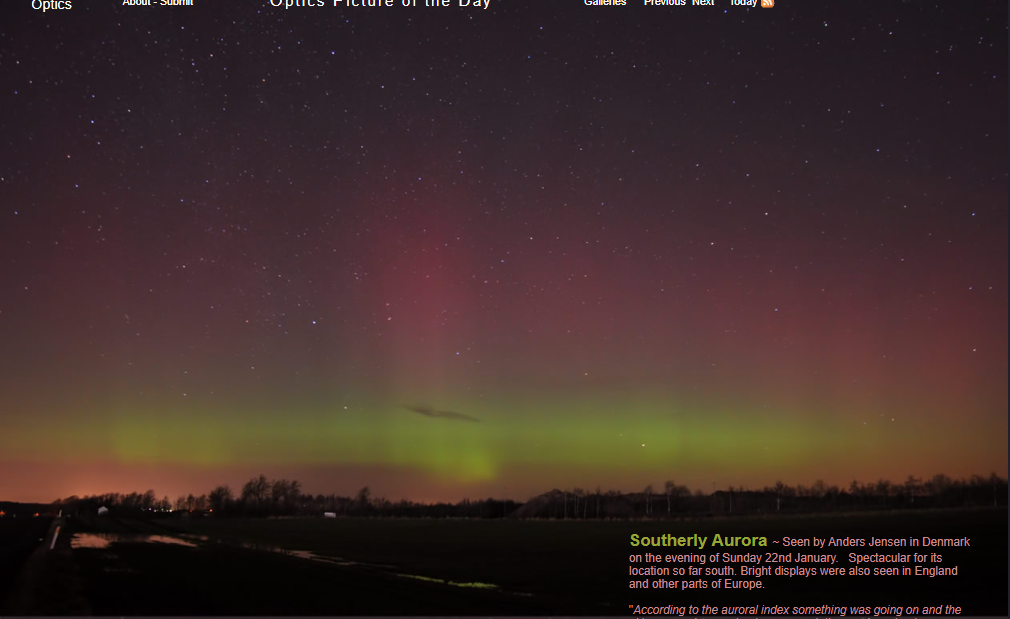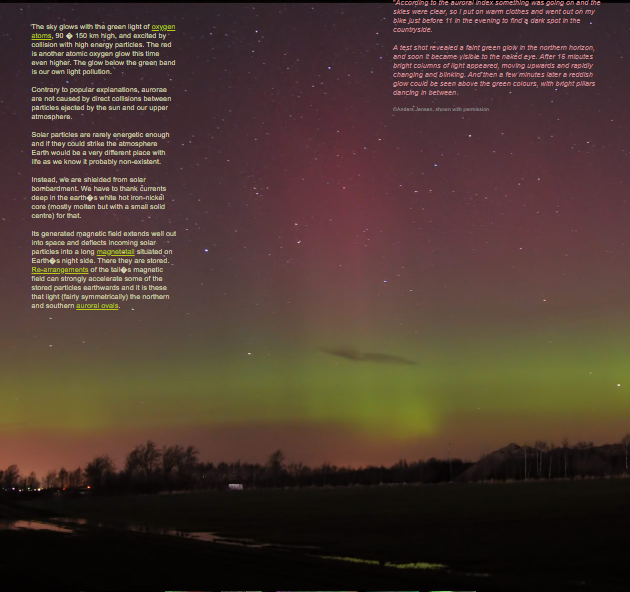OPOD - Southerly Aurora
OPOD - Southerly Aurora: A Spectacular Natural Phenomenon
The evening of Sunday, January 22nd, was a truly remarkable night for skygazers in Denmark and other parts of Europe. Anders Jensen, a passionate aurora enthusiast, had the privilege of witnessing a southerly aurora in Denmark, which is an extraordinary occurrence given its location so far south. This rare display of vibrant colors captivated the hearts of many, leaving them in awe of the wonders of the natural world.
Curiosity and a sense of adventure prompted Anders to venture out into the countryside after noticing indications of auroral activity in the auroral index. Equipped with warm clothing and his trusty bicycle, he sought out a dark spot to observe this celestial spectacle. Just before 11 PM, as he gazed towards the northern horizon, a faint green glow caught his attention. Gradually, this ethereal glow became visible to the naked eye, growing in intensity with each passing moment.
After approximately 15 minutes, Anders was treated to an even more breathtaking sight. Bright columns of light emerged, moving upwards and constantly changing their shape and rhythm. The air seemed to dance with vibrant energy as the aurora displayed its mesmerizing performance. A few minutes later, a reddish glow appeared above the green hues, enhancing the enchanting ambiance. Bright pillars danced gracefully amidst this ethereal canvas, weaving an intricate tapestry of light.
The luminous spectacle of a southerly aurora is a result of the interaction between solar particles and the Earth's upper atmosphere. Contrary to popular belief, these awe-inspiring displays are not caused by direct collisions between solar particles and our atmosphere. In fact, if solar particles were able to strike our atmosphere with enough force, life on Earth as we know it would likely cease to exist.
We owe our protection from solar bombardment to the currents deep within the Earth's white-hot iron-nickel core. This molten core, with its small solid center, generates a magnetic field that extends far out into space. This magnetic field deflects incoming solar particles into a long magnetotail situated on the Earth's night side, where they are stored. Perturbations in the magnetic field of the magnetotail can accelerate some of these stored particles towards Earth, resulting in the symmetrical illumination of the northern and southern auroral ovals.
The vibrant green glow witnessed during a southerly aurora is caused by oxygen atoms located approximately 90 to 150 kilometers above the Earth's surface. These atoms become excited through collisions with high-energy particles, emitting the distinctive green light that captivates observers. The appearance of red hues in the aurora is also attributed to atomic oxygen, but this time at even higher altitudes.
As observers marvel at the celestial ballet unfolding before their eyes, it's important to acknowledge the impact of light pollution on our perception of the aurora. The glow below the green band is a reminder of our own artificial light sources that diminish the natural splendor of the night sky. Finding a dark spot away from urban areas allows for a more immersive experience, where the full majesty of the aurora can be appreciated.
The southerly aurora witnessed by Anders Jensen serves as a testament to the captivating beauty of atmospheric optics. It reminds us of the intricate interplay between solar particles, our planet's magnetic field, and the delicate dance of atoms in the upper atmosphere. Such celestial displays are a humbling reminder of the vastness and complexity of our universe, inspiring wonder and awe in all who have the privilege of witnessing them.

Southerly Aurora ~ Seen by Anders Jensen in Denmark on the evening of Sunday 22nd January. Spectacular for its location so far south. Bright displays were also seen in England and other parts of Europe.
"According to the auroral index something was going on and the skies were clear, so I put on warm clothes and went out on my bike just before 11 in the evening to find a dark spot in the countryside.
A test shot revealed a faint green glow in the northern horizon, and soon it became visible to the naked eye. After 15 minutes bright columns of light appeared, moving upwards and rapidly changing and blinking. And then a few minutes later a reddish glow could be seen above the green colours, with bright pillars dancing in between.
©Anders Jensen, shown with permission

The sky glows with the green light of oxygen atoms, 90 � 150 km high, and excited by collision with high energy particles. The red is another atomic oxygen glow this time even higher. The glow below the green band is our own light pollution.
Contrary to popular explanations, aurorae are not caused by direct collisions between particles ejected by the sun and our upper atmosphere.
Solar particles are rarely energetic enough and if they could strike the atmosphere Earth would be a very different place with life as we know it probably non-existent.
Instead, we are shielded from solar bombardment. We have to thank currents deep in the earth�s white hot iron-nickel core (mostly molten but with a small solid centre) for that.
Its generated magnetic field extends well out into space and deflects incoming solar particles into a long magnetotail situated on Earth�s night side. There they are stored. Re-arrangements of the tail�s magnetic field can strongly accelerate some of the stored particles earthwards and it is these that light (fairly symmetrically) the northern and southern auroral ovals.
Note: this article has been automatically converted from the old site and may not appear as intended. You can find the original article here.
Reference Atmospheric Optics
If you use any of the definitions, information, or data presented on Atmospheric Optics, please copy the link or reference below to properly credit us as the reference source. Thank you!
-
<a href="https://atoptics.co.uk/blog/opod-southerly-aurora/">OPOD - Southerly Aurora</a>
-
"OPOD - Southerly Aurora". Atmospheric Optics. Accessed on December 27, 2024. https://atoptics.co.uk/blog/opod-southerly-aurora/.
-
"OPOD - Southerly Aurora". Atmospheric Optics, https://atoptics.co.uk/blog/opod-southerly-aurora/. Accessed 27 December, 2024
-
OPOD - Southerly Aurora. Atmospheric Optics. Retrieved from https://atoptics.co.uk/blog/opod-southerly-aurora/.